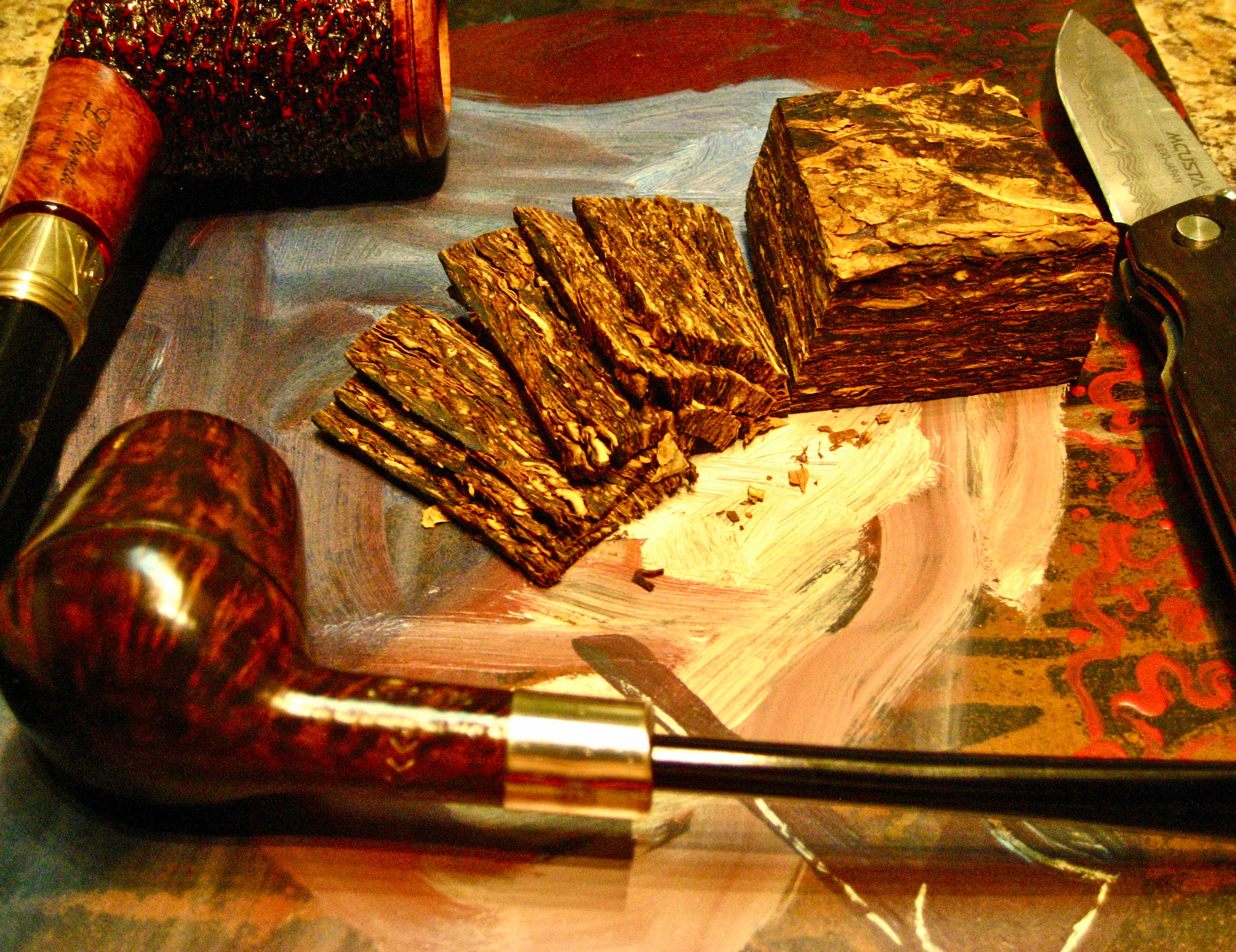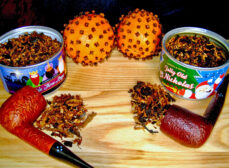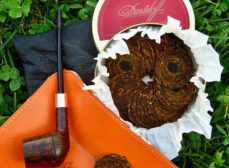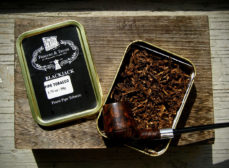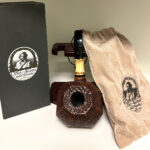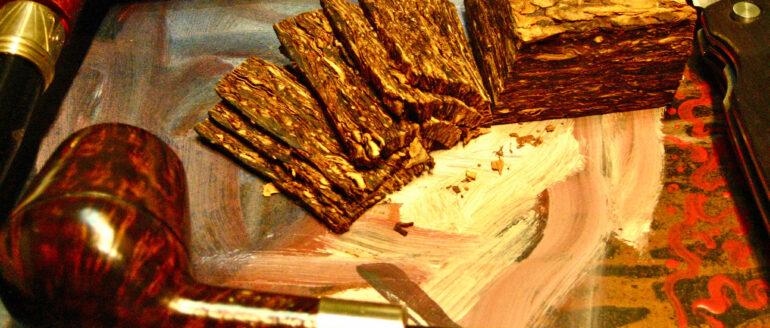
Of course the tin caught my eye, how could it not? I’ve oft-professed my love of Modern art, particularly the era of Cubism and Brutalism and Neo-Plasticism, going so far as to foist it on you good people of the pipe-smoking public on occasion – The Pipe in Art: Juan Gris. So what was this pastiche of color on the tobacconist’s shelf? A new GL Pease blend, you say? Not only that, but a plug-cut, Virginia-Oriental blend? And it’s called ‘géométrie’? Well, you had me at Cubism.
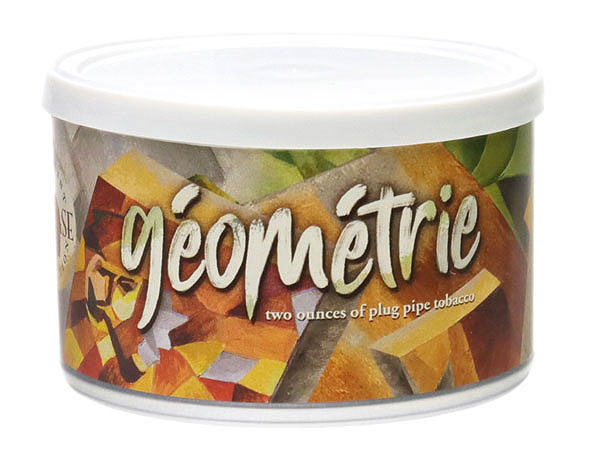
Moving past the lovely artwork adorning géométrie, the second installment of the ‘Zeitgeist’ collection, the description on the tin tells me that I’m practically guaranteed to fall in love with this blend:
Overlapping planes of vintage, sun-cured Basma and Izmir leaf reframe the malty, natural sweetness of mature red Virginias in this modern expression of the classical Virginia/ Oriental archetype. Aged in cakes to deepen and enrich the flavors, this structured, plug-cut tobacco is poised to engage and intrigue all of the senses.
Basma is a variety I’ve been fond of for some considerable time, since obtaining a pound of it from a fellow named Mark Ryan many years back. What I found in Basma was the component I didn’t know I’d been looking for—it turned my Virginia and Virginia-Perique blends into veritable malted milkshakes of tobacco-flavored goodness, imparting in them new textures and frames of reference which I hadn’t known existed. For this reason I’ve always kept a jar of it on hand for home blending and dressing-up familiar blends to give them new life. The flavor profile of Basma when smoked by itself is lightly sweet, mild, and floral, but in the absence of other leaf to play off of (and regulate burn) it quickly devolves into a rather bitter bouquet; “too much of a good thing…” being pertinent advice here. However, when added in slight percentage to almost any blend, magic happens every time. Sweet, sugar-laden Virginia profiles at once become couched in a creamy aspect that rounds all the sharp edges yet still allows the original tobaccos to express their individual voices. Basma’s own floral sweet and sour notes prove to be the perfect adjunct to all the common flavors and aromas in many blends: filling them out, amplifying or tempering them, and imparting its own color and a wonderfully smooth mouthfeel. Take any old Virginia-based blend that has grown dull from repetition, add some Basma, and you’ve got magic on your hands; I’ve even gone so far as to commit heresy by mixing it with vintage Escudo—and consider it only an improvement on perfection. In géométrie it is a relatively minor player, primarily softening the Izmir and providing a soothing counterpoint to the Red Virginia.
Izmir, also known as Smyrna, leaf is of course well-known as a base constituent, used in most cigarette blends; its name is practically synonymous with the ‘Oriental’ or ‘Turkish’ tobacco flavor that dominates that market and is a good percentage of the pipe blends spectrum. Sourced from the Aegean region whence it is named, grown in rocky volcanic soil with ample drainage, Izmir’s flavor profile tends toward a slightly sharper shade of sweet and sour; lightly floral yet tangy, somewhat woody and nutty, mildly acrid with resinous overtones—think frankincense and myrrh. It’s used here with meticulous proportion, meted out in just the right measure so as to shepherd but not to overwhelm the blend entirely. Together with the Basma, the Orientals control the burn, temper and direct the sweetness, enrich the earthy notes, and give the entire composition a cohesive character.
Opening the fresh tin, evidence of the Virginias’ anaerobic fermentation dominate: deep raisin, the umami of ketchup, gumdrop, green grape must, and dry leather. From the Orientals there are hints of pine: fresh spruce sap on the sweet end and creosote on the sour end; the earthy aroma spectrum also evinces potting soil, marigold, and occasional honeysuckle highlights. After some days exposed to air, the plug’s bouquet is more melded, emanating essences bready and woody and nutty: cinnamon-raisin bagel, walnut shell, old leather, stale red wine. As the days went by, I noted the overall impression of the nose sweetened, softened, and yet gained nuance all the same—some new scent-impression would seem to appear every time the tin was opened for a whiff.
In the bowl, géométrie is exactly the malty, tangy concoction I’d anticipated. To prepare it I first went for a cube cut, which gave an excellent feel for the overall composition, but little separation of flavors. I then sliced a few flakes, though their inconsistency is testament to my failing eyesight—slight rant here, but if Mr. Pease continues to come out with amazing plug tobaccos, he could at least have the decency to also start selling little tobacco guillotines to go with them. Nonetheless, the preparation proved to allow the interplay of those layers to really emerge and give the impressions that we’re going for. Again and again, when speaking of GL Pease blends, one marvels at the absolutely perfect balance that is struck with the mixtures. Everything in its place, and a place for everything. Though it took some tending, the smoke really opened up with a fold & stuff method. Flavors would come alive, lend their voice, and then recede; there was a dynamism and rhythm that was absent from the cube-cut bowls. Often the character of the smoke veered to the spicy hints of shade-leaf cigars, with notes of allspice, clay, and tannin. In a few moments of just leaning back to daydream about the smoke, it was easy to envision slow walks amongst dusty library stacks, and paint drying on canvas.
Perhaps above everything else, this is an easy blend to smoke. Light, yet full of flavor; sweet, yet tempered with spicy sour; rich, yet smooth and dry on the palate. It has all the complexity and nuance for meditative, ruminative smokes, yet is mild enough for revisiting a few times in a day. It definitely has its moment now, in the swelter of summer, as an excellent hot-weather smoke. With the recent high temperatures and equally high humidity, the blend fares remarkably well and becomes truly outstanding when smoked out-of-doors. Mr. Pease himself allows that géométrie is purpose-built for aging, despite tasting so fantastic already; clearly the selection of leaf was made with this journey in mind. It of course made sense to purchase not one but several tins, for the sake of science mind you, in order to resample such a singular smoke periodically and chart its progress. It’s clear that Pease is enamored of tobacco, and paints with it as an artist would; it is lucky for us that his art is able to be shared thus.
“The truly modern artist is aware of abstraction in an emotion of beauty.” – Piet Mondrian
